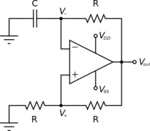electonicsproject
Banned

Hello,
How to build circuit square wave form multi vibrator from 741 ic??
How to build circuit square wave form multi vibrator from 741 ic??
Follow along with the video below to see how to install our site as a web app on your home screen.
Note: This feature may not be available in some browsers.







You should specify your requirements explicitly. To get a linear and constant frequency PWM, three OPs (or more exactly, one OP and two comparator functions are needed.hello triangular is also generated after integrating a square wave how to get pwm?

You can study existing pwm controller ICs to learn about it.






ok, what will be the use of it in circuit?Two error amplifiers can be e.g. used for constant V/ constant I power supply.




